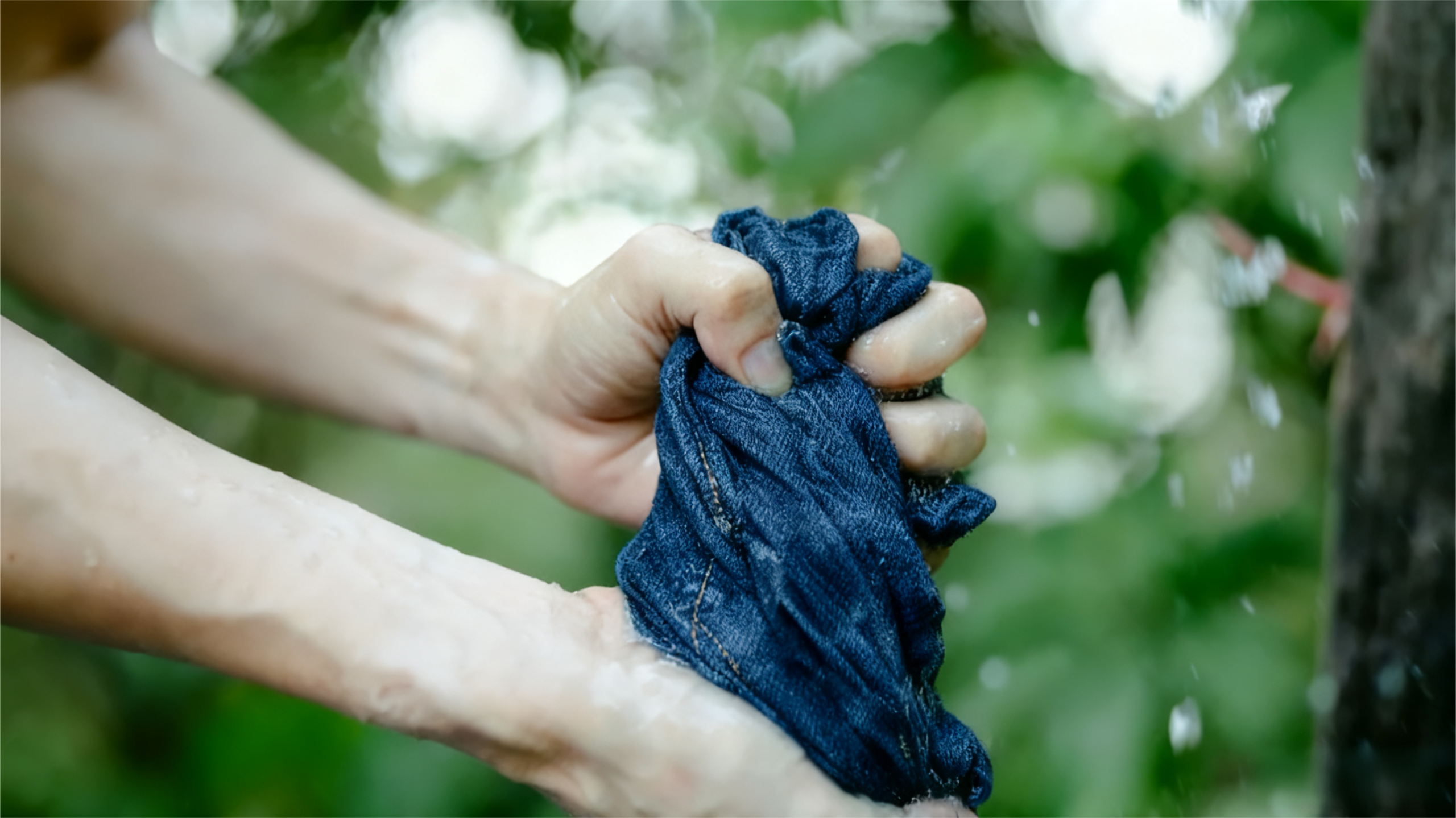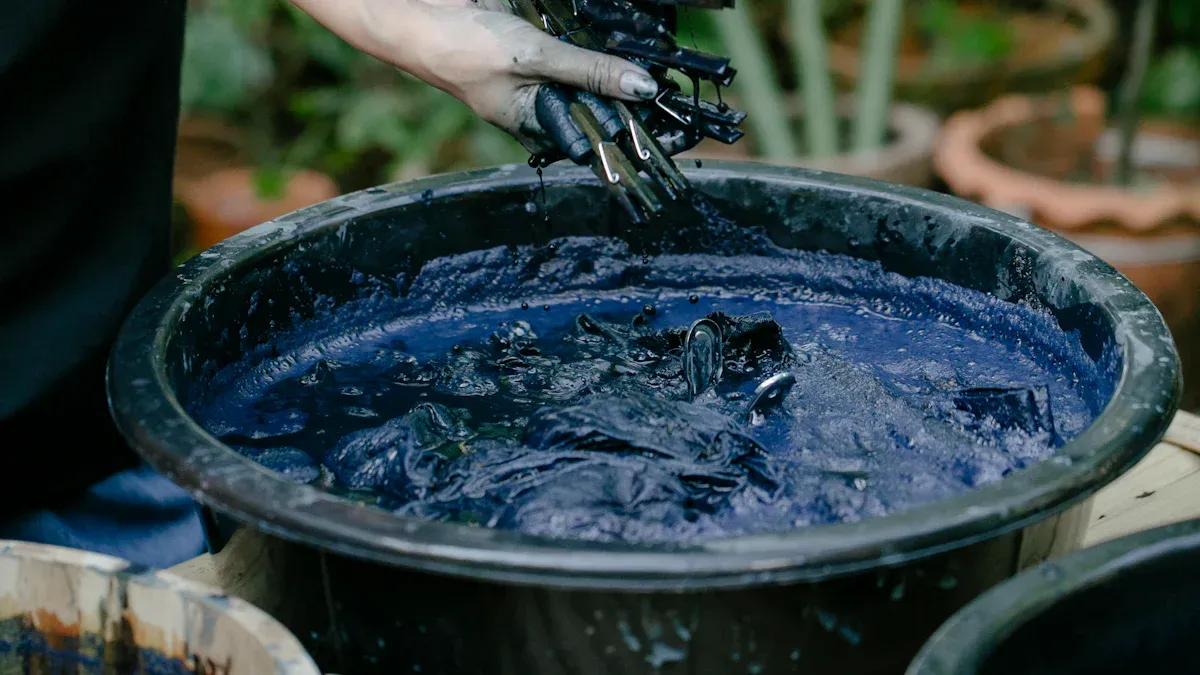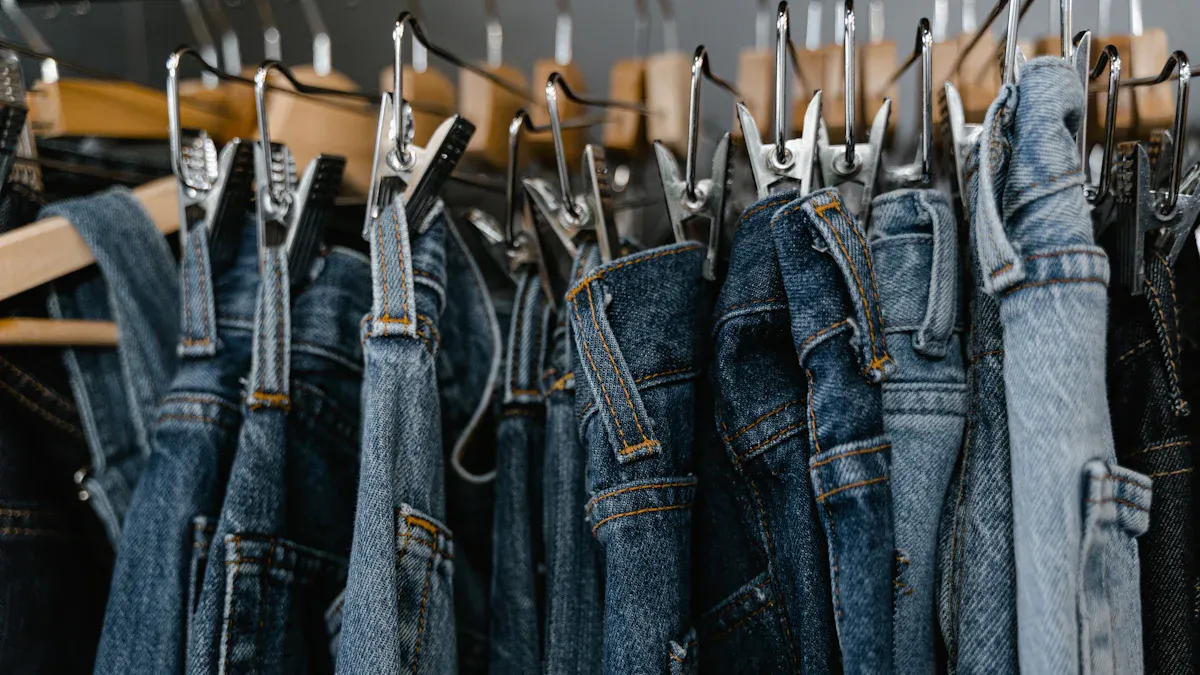
You see denim everywhere, but few realize the impact traditional dyeing has on the environment. Producing a single pair of jeans can use up to 10,000 liters of water. Dyeing and finishing processes drive much of this consumption. Chemical-heavy steps like sandblasting and bleaching harm both workers and nature.
Waterless dyeing technique offers a smarter solution. When you look at Waterless Denim Dyeing Methods, you find huge water and energy savings:
Dyeing Method | Water Savings | Energy Savings |
|---|---|---|
Foam Dyeing | 70% | N/A |
Air Dyeing | Up to 96% | 84% |
Dope Dyeing | Eliminates dye baths | N/A |
You benefit from cleaner jeans and a healthier planet. Manufacturers save resources, and consumers support sustainability.
Key Takeaways
Waterless dyeing methods can save up to 96% of water compared to traditional techniques, helping to conserve this vital resource.
Choosing jeans made with waterless dyeing supports sustainability and reduces pollution, benefiting both the environment and local communities.
Innovative techniques like supercritical CO₂ dyeing and laser finishing create high-quality denim while minimizing chemical use and waste.
Look for brands that use waterless dyeing methods to make informed choices that contribute to a cleaner planet.
The shift towards sustainable denim production is growing, driven by consumer demand for eco-friendly products and innovative technologies.
Why Traditional Denim Dyeing Must Change
Water and Chemical Use
You might not realize how much water and chemicals go into making your favorite jeans. Traditional denim dyeing uses more water than almost any other textile process. The dyeing, bleaching, and finishing steps together consume over half of the water used in the entire textile industry. Each pair of jeans can require more than 790 gallons of water. This heavy demand often depletes local water sources, leaving communities with less clean water.
The process also relies on chemicals like sodium hydroxide and synthetic dyes. These chemicals help fix the color but create toxic by-products. Factories often discharge untreated wastewater, which carries these chemicals into rivers and lakes. Workers face health risks from chemical exposure, including respiratory diseases such as silicosis. Synthetic dyes and heavy metals can harm both people and the environment.
💡 Did you know? The average pair of jeans emits between 10 and 30 kilograms of CO₂ during production. The textile industry, including denim, releases about 1.2 billion tonnes of CO₂ every year.
Environmental Impact
When you choose denim, you also affect the environment. Traditional dyeing methods contribute to water pollution and ecosystem damage. About 20% of global clean water pollution comes from textile production, mainly from dyeing processes. Chemical runoff from denim factories can harm local populations, animals, and entire ecosystems.
Untreated wastewater often contains synthetic dyes and carcinogenic chemicals.
These substances pollute waterways, endanger aquatic life, and pose health risks to nearby communities.
The prevalence of synthetic dyes in wastewater creates long-term environmental problems.
Chemical runoff from denim production can damage soil and disrupt food chains.
You can see why the industry needs to change. Cleaner methods will help protect water sources, reduce pollution, and create safer working conditions. By understanding these impacts, you make informed choices and support a healthier planet.
Main Waterless Denim Dyeing Methods

You see a growing number of waterless denim dyeing methods changing how denim gets its color. These methods use less water, fewer chemicals, and create less pollution. You can group the main technologies into four categories: supercritical CO₂ dyeing, foam and spray dyeing, air and dope dyeing, and closed-loop systems.
Supercritical CO₂ Dyeing
You may hear about supercritical carbon dioxide dyeing as one of the most advanced waterless denim dyeing methods. This process uses carbon dioxide in a supercritical state instead of water. You get up to 95% less water usage and 58% lower carbon emissions. You avoid chemical effluent and energy-intensive drying. The color quality stays high, especially for polyester and synthetic fabrics.
Supercritical CO₂ dyeing works by pushing carbon dioxide into a supercritical state, where it acts like both a liquid and a gas. You mix dye with the CO₂, which penetrates the fibers deeply. When the pressure drops, the dye separates from the CO₂, leaving no wastewater. You see long-term savings in water and chemicals, even though the machines cost more at first. You also save energy because you skip the drying step.
💡 Tip: Brands like DyeCoo use supercritical CO₂ dyeing to produce denim with almost no water or chemical waste.
Foam and Spray Dyeing
You find foam dyeing and spray dyeing among the most efficient waterless denim dyeing methods. Foam dyeing mixes dyes into a foam medium, which uses much less liquid than traditional dye baths. You apply the foam directly to the yarn or fabric. Heat treatment fixes the color, so you need little rinsing. You can save up to 99% of water with this method.
Spray dyeing works by spraying dye onto the fabric in a controlled way. You get even coverage and use less dye. Both foam dyeing and spray dyeing reduce chemical waste and energy use. You see companies like NTX and Jeanologia using these methods to create sustainable denim.
Foam Preparation: You mix dye into foam, reducing liquid use.
Application: You apply foam or spray directly to fabric.
Fixation: You use heat to set the color, saving water.
Air and Dope Dyeing
You see air dyeing as a standout among waterless denim dyeing methods. Air dyeing uses air to transfer dye onto fibers, so you do not need water at all. You avoid chemical discharge and get high precision in color application. You also save energy because you do not need heating or drying.
Dope dyeing works differently. You add color to the fiber before spinning it into yarn. You skip the dye bath, so you use no water. You get consistent color and less waste. Both air dyeing and dope dyeing help you reduce environmental impact and improve efficiency.
Feature | Air Dyeing Technology | Other Waterless Methods |
|---|---|---|
Water Usage | 100% waterless | Varies, but generally low |
Chemical Discharge | May still involve some chemicals | |
Color Application | High precision in dye application | Varies, often less precise |
Energy Efficiency | Reduced heating and drying requirements | Varies, may require more energy |
Environmental Impact | Significantly reduces environmental impact | Generally lower impact, but varies |
Closed-Loop and Enclosed Systems
You see closed-loop and enclosed systems as important waterless denim dyeing methods. These methods recycle dyes and chemicals within the system, so you do not release waste into the environment. You use less water and energy, and you keep chemicals out of rivers and lakes.
You find technologies like E-Flow and ozone dyeing in this group. E-Flow uses supercritical CO₂ for dyeing without water. Ozone dyeing uses ozone gas to help dye absorption, which reduces water and chemical use. Digital printing also fits here, applying dye directly with inkjet technology and creating almost no waste.
Technology | Description | Environmental Benefits | Ideal For |
|---|---|---|---|
E-Flow | Utilizes supercritical CO₂ for dyeing without water, reducing chemical use. | No water consumption, Reduced energy use, Minimal chemicals involved | Denim, cotton, synthetic fabrics |
Ozone Dyeing | Uses ozone gas to enhance dye absorption, reducing water and chemical use. | Reduces water and chemical usage, Energy efficient, Minimizes fabric damage | Denim, synthetic fabrics |
Digital Printing | Applies dye directly using inkjet technology, minimizing waste and water. | No water required, Minimal waste, Lower chemical usage | High-fashion apparel, custom designs, digital prints on denim |
You see these waterless denim dyeing methods making denim production cleaner and more efficient. You help protect the environment and support sustainable fashion when you choose denim made with these methods.
Waterless Denim Finishing Techniques
You see denim finishing as a crucial step in creating the look and feel of your jeans. Waterless denim finishing methods now let you enjoy stylish denim while protecting the environment. These advanced techniques use little or no water, fewer chemicals, and less energy. You help drive the shift toward sustainable fashion when you choose jeans made with these processes.
Laser Finishing
You notice laser finishing as a game-changer in waterless denim finishing. Lasers use light beams to create patterns, fades, and distressed effects on denim without water or harsh chemicals. You get precise control over the design, from vintage looks to whiskers and even intentional damage like holes and tears. Lasers can replicate the effects of potassium permanganate and sandblasting, but you avoid the pollution and health risks.
Laser finishing gives you consistent results and high visual accuracy.
You see brands like Levi’s and Jeanologia using lasers for eco-friendly denim.
Lasers preserve the strength of the fabric, so your jeans last longer.
💡 Laser washing achieves worn effects with less environmental impact. You get the same stylish look as traditional methods, but with cleaner production.
Ozone and Nano-Bubble Treatments
You find ozone and nano-bubble treatments at the forefront of waterless denim finishing. Ozone gas helps bleach and fade denim without water or toxic chemicals. Nano-bubble technology uses tiny bubbles to treat fabric with minimal liquid. You see these methods saving water and energy while reducing pollution.
Benefit | Description |
|---|---|
Water Savings | |
Energy Efficiency | Cuts energy use by up to 47%. |
Chemical Reduction | Eliminates harmful chemicals from the process. |
Eco-Friendly Processing | Ozone gas breaks down into oxygen, lowering pollution. |
Reduces Chemical Dependency | Minimizes need for traditional bleaching agents. |
You see companies like Advance Denim and Wdenim leading the way with ozone and nano-bubble systems. These technologies let you enjoy faded denim styles while supporting cleaner manufacturing.
Enzyme and Eco-Friendly Sprays
You discover enzyme and eco-friendly spray treatments as another important part of waterless denim finishing. Enzymes replace harsh chemicals, breaking down indigo dye and creating natural faded effects. Eco-friendly sprays use alternatives like hydrogen peroxide and sodium dithionite, which lower the environmental impact.
Conventional finishing sprays, such as potassium permanganate, have higher environmental scores.
Enzyme treatments and eco-friendly sprays achieve lower scores, showing a more sustainable approach.
You get jeans with a soft feel and authentic look, but with less harm to the planet.
You see brands adopting bio-enzymes and closed-loop neutralization systems to manage waste and improve safety. These advancements make denim finishing safer for workers and better for the environment.
🌱 Waterless denim finishing now includes nano-bubble technology, bio-enzymes, and waterless dyeing systems like Indigo Zero. You help reduce water and chemical use every time you choose denim made with these innovations.
Latest Advancements in Waterless Denim Finishing
Advancement Type | Description |
|---|---|
Nano-bubble technology | Enables low-liquor treatments, significantly reducing water usage. |
Systems like Indigo Zero apply dye without water, minimizing waste. | |
Bio-enzymes | Replace toxic chemicals, promoting a safer production process. |
Closed-loop neutralization systems | Manage effluents effectively, contributing to sustainability in denim finishing. |
You see waterless denim finishing evolving quickly. Companies use foam, mist, and supercritical CO₂ dyeing to eliminate water-based vats. Brands like Adidas and DyeCoo set new standards for vibrant, sustainable denim. You support a cleaner future by choosing jeans finished with these advanced methods.
How Methods Work and Their Benefits
Mechanisms Explained
You see waterless dyeing methods using science to create strong color and quality in denim. These methods rely on how dye molecules interact with fibers. You get color fastness through several forces:
Van der Waals forces help dyes stick to fibers.
Hydrogen bonding creates a strong link between dye and fabric.
Ionic bonding and covalent bonding make the color last longer.
Entrapment and mechanical retention keep the dye inside the fiber.
You notice that different fibers and dyes work together in unique ways. New dye molecules and surface treatments improve color retention and support sustainability. Ultrasound-assisted dyeing uses sound waves to help dye penetrate fibers more deeply, which boosts color quality and reduces chemicals.
Environmental and Economic Advantages
You benefit from waterless dyeing because it saves water and energy. These methods use less water, which means you see water savings and lower carbon footprint. You also see reduced chemicals in the process. Ultrasound-assisted dyeing and other advanced techniques cut down on energy use, making denim production more efficient.
Waterless dyeing methods lower operational costs and reduce pollution. You help the planet by choosing jeans made with these technologies.
Advantage | Waterless Dyeing | Traditional Dyeing |
|---|---|---|
Water Usage | High volumes required | |
Pollution | Many pollutants eliminated | High levels of pollutants |
Waste | Less waste due to precise control | More waste generated |
Energy Consumption | Lower energy consumption | Higher energy consumption |
You see that manufacturers save money over time, even if new machines cost more at first. Ultrasound-assisted dyeing and other waterless methods help companies manage waste better and meet environmental rules.
Sustainability in Denim Production
You support sustainability when you choose denim made with waterless dyeing. These methods use less water and fewer chemicals, which helps fight global water scarcity. Ultrasound-assisted dyeing and other innovations align with your desire for eco-friendly products. Brands improve their reputation and meet regulations by using these techniques. You help create a future where denim production has a lower carbon footprint and supports long-term sustainability goals.
Industry Adoption and Future of Sustainable Dyeing Techniques

Leading Brands and Innovations
You see many brands leading the way with sustainable dyeing techniques. Gap Inc. has saved over 229 million liters of water through its Washwell™ initiative. The Dry Indigo® technique uses 99% less water and 89% less chemicals than older methods. Lab Denim Inc. introduced a post-weave colourisation process that colors denim after weaving, cutting water use by more than 90%. Adidas uses DyeCoo’s CO2 dyeing technology for sportswear, showing how waterless technologies work beyond denim. Stella McCartney creates vibrant patterns for accessories with air dyeing, reducing waste. Technical textiles for cars and outdoor gear now use plasma-assisted dyeing, passing tough durability tests.
You support these innovations every time you choose products made with sustainable dyeing techniques. Brands use closed-loop water recycling and digital printing processes to create cleaner, more efficient production.
Major Innovations in Sustainable Dyeing Techniques:
Post-weave colourisation by Lab Denim Inc.
Dry Indigo® waterless technologies
Plasma-assisted dyeing for technical textiles
DyeCoo’s CO2 dyeing for sportswear
Air dyeing for sustainable accessories
Market Trends and Future Prospects
You notice a strong shift in the global market toward sustainable dyeing techniques. Foam dyeing and cold pad batch processes now make up 27% of denim production worldwide. These water-saving solutions help save over 100 million liters of water each year in places like India and Bangladesh. Waterless technologies can save up to 134 liters of water per garment. Plasma-assisted dyeing and sustainable methods are expanding into fashion, home textiles, and accessories.
You see that consumer demand for eco-friendly products drives this change. Sustainable textile processing is becoming the norm. Brands use digital printing processes to reduce waste and energy use. However, you should know that scalability and fabric complexity remain barriers to wider adoption. Plasma-assisted dyeing and other sustainable dyeing techniques will continue to grow as technology improves.
You help shape the future of denim and textiles by choosing products made with sustainable dyeing techniques and water-saving solutions.
You see waterless denim dyeing and finishing methods changing the way jeans are made. These innovations, like CO₂ dyeing and digital pigment printing, cut water use and chemical runoff. New techniques keep improving:
Waterless dyeing uses pressurized CO₂ to prevent pollution.
Laser finishing creates patterns with less waste.
Ozone-based bleaching lowers chemical discharge.
You help drive this change. The sustainable textiles market is set to grow fast, and more people want eco-friendly products. Denim’s future looks cleaner and brighter.
FAQ
What makes waterless denim dyeing better for the environment?
You help save water and reduce pollution when you choose waterless denim. These methods use less water and fewer chemicals. Factories release less wastewater, so rivers and lakes stay cleaner.
Can waterless dyeing affect the quality or color of denim?
You still get strong, vibrant colors with waterless dyeing. New technology lets dyes bond well with fibers. Your jeans look and feel the same as traditional denim, but with less environmental impact.
Are waterless denim products more expensive?
You may see a slightly higher price at first. Over time, as more brands use these methods, costs drop. You help support innovation and a cleaner planet when you buy waterless denim.
How can you tell if your jeans use waterless dyeing?
You can check the label or brand website. Many companies highlight waterless or sustainable processes. Look for certifications or terms like “Dry Indigo,” “CO₂ dyeing,” or “foam dyeing.”
